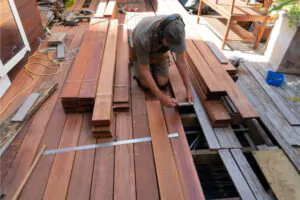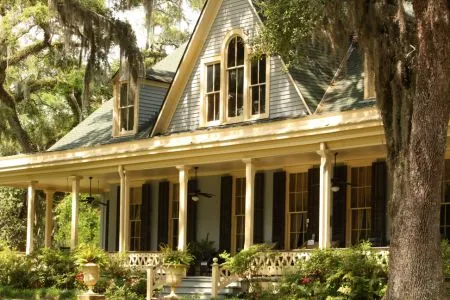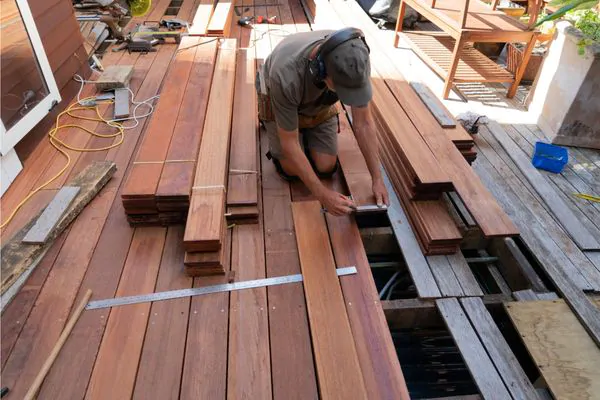Choosing the right wood for your deck can feel like a big puzzle. Cedar, Redwood, and Pressure Treated Pine stand out as top picks, known for their vibrant colors and durability. This guide will walk you through each option’s pros and cons to make deciding easier.
Get ready to find your perfect match for outdoor living space!
Key Takeaways
- Pressure-treated wood offers affordability and durability, making it a popular choice for decks in areas like Colorado. It undergoes a special treatment to resist rot and insect damage, which can extend the life of your deck.
- Cedar and redwood provide natural beauty with their unique colors and textures. These woods are naturally resistant to decay, adding longevity to your deck without the need for frequent maintenance.
- Exotic hardwoods such as ipe and teak stand out for their exceptional durability and distinctive appearance. They offer a higher resistance to rot compared to other options, though they come at a higher cost.
- Composite decking is low maintenance and comes in various colors, mimicking the look of wood while offering greater durability against weathering. It’s made from recycled materials, making it an eco-friendly choice.
- Choosing the right material for your deck involves considering factors like budget, maintenance needs, environmental impact, and how you plan to use your outdoor space.
Traditional Wood Options for Decks
When considering traditional wood options for decks, it’s important to explore a range of materials. Different woods offer unique characteristics that can greatly impact the overall look and feel of your outdoor space.
Pressure-Treated Wood
Pressure-treated wood makes the race for the top choice in building outdoor decks, especially for those living in Colorado. This type of lumber undergoes a special process that involves soaking it in a protective preservative under high pressure.
This method ensures deep penetration of the chemicals, making the wood resistant to rot and insect damage. Opting for pressure-treated wood means picking a material that stands strong against the whims of weather and time.
Cost plays a big part when planning your deck, and here’s where pressure-treated lumber shines again. It is more budget-friendly than other options like composite decking or exotic hardwoods.
Not just kind to your wallet upfront, this material also scores points for its durability, minimizing repair and replacement costs over time. Its resilience against decay extends its life, making it a wise investment for any homeowner.
From personal experience with deck projects around Colorado, I’ve seen how well pressure-treated wood holds up year after year – even through harsh winters and blazing summers. It’s clear why many experts recommend this sturdy yet affordable option.
Choosing pressure-treated lumber for your deck isn’t just about cost; it’s investing in longevity.
Cedar and Redwood
Cedar and redwood stand out as top choices for deck builders in Colorado. These woods bring a natural beauty to outdoor spaces, thanks to their distinct colors and textures. Cedar decks are known for their durable yet relatively soft surfaces, making them comfortable underfoot.
This wood’s ability to resist rot and decay adds to its appeal for deck construction.
Redwood is another excellent option, famous for its rustic look filled with knots and deep reddish tones that catch the eye. Over time, redwood weathers gracefully into a charming gray hue without losing its resistance to moisture or pests.
Both cedar and redwood offer homeowners the classic aesthetics of real wood coupled with longevity and minimal maintenance requirements.
Opting for these materials means investing in the ruggedness needed for Colorado’s varied climate while enjoying an outdoor area that feels timeless and warm. With proper deck maintenance, both cedar and redwood can serve as stunning backdrops for gatherings or peaceful retreats at home, blending seamlessly with the natural landscape.
Exotic Hardwoods
Exotic hardwoods like ipe, garapa, and tigerwood stand out for their unbeatable durability and distinct look. These woods come from far-off forests and bring a touch of exotic beauty to decks in Colorado.
Builders and homeowners favor these materials because they last longer than pressure-treated wood or even cedar.
Choosing ipe, mahogany, or teak means your deck will resist rot better due to the high fiber density these woods offer. This makes them not just strong but also a smart choice for anyone wanting a deck that stands the test of time without losing its appeal.
Plus, their unique color and grain patterns add an upscale feel to outdoor spaces that few other building materials can match.
Alternative Decking Materials
Alternative decking materials offer a range of options that can suit various preferences and needs. These materials provide alternatives to traditional wood decking, allowing for greater versatility and durability in deck construction.
Composite Decking and Plastic Lumber
Composite decking and plastic lumber offer a durable and sustainable alternative to traditional wood options. Made from a blend of organic wood flakes and recycled plastics, composite decking is known for its resistance to UV and water damage, ensuring longevity without fading, splitting, or splintering.
This versatile material combines the natural beauty of real wood with the strength of composite materials. Additionally, Wood-Plastic Composites (WPC) made from recycled materials provide a more eco-friendly choice for outdoor decks.
Moreover, these materials last longer than traditional wood and plastic decking while requiring minimal maintenance.
Moreover, individuals seeking low-maintenance outdoor flooring should consider composite decking due to its unparalleled durability against the elements. It provides an excellent opportunity for enhancing outdoor spaces with sustainable yet visually appealing deck boards that stand the test of time.
Aluminum
Aluminum decking stands out as an eco-friendly and highly recyclable alternative material for outdoor spaces like decks, patios, and porches. The polyurea coating enhances its durability to match that of wood or composite decking, making it a sustainable choice.
Furthermore, aluminum bracing and support not only save weight but also allow for more flotation compared to traditional wood options. With uniquely designed boards meant to provide years of enjoyment, aluminum decking proves to be a practical and environmentally conscious solution.
Its eco-friendliness is evident in the fact that aluminum is infinitely recyclable, making it ideal for environmentally conscious homeowners seeking sustainable deck options. Additionally, the polyurea coating on aluminum deck boards ensures that they can withstand the rigors of outdoor use while still providing the aesthetic appeal of wood or composite materials.
This makes aluminum an attractive choice for those looking to balance environmental responsibility with performance and longevity in their deck building projects.
Choosing the Best Material for Your Deck
When it comes to selecting the best material for your deck, there are several important factors to consider. Cost, maintenance requirements, and performance should all be carefully weighed before making a decision.
Comparing different wood options and alternative materials can help you make an informed choice that suits your needs.
Factors to Consider
When selecting the ideal decking material for your project, consider the following factors:
- Budget: Evaluate the initial cost and long-term expenses associated with each decking material. Take into account installation, maintenance, and potential replacement costs over time.
- Durability: Assess the resistance of different materials to factors such as weather, pests, and wear and tear to ensure longevity.
- Maintenance Requirements: Consider the upkeep needed for each type of decking material, including cleaning, sealing, and potential repairs.
- Specific Outdoor Living Space Needs: Tailor your choice to match the intended use of your deck area, whether for entertaining, relaxation, or a combination of activities.
By carefully considering these factors, you can make an informed decision that aligns with both your vision and practical needs for your deck in Colorado.
Cost and Maintenance
The cost of wood decking varies based on the type of wood chosen, ranging from $3 to $12 per square foot for material costs. While softwood is more affordable, hardwoods like cedar and redwood can be pricier due to their natural resistance to decay.
On the other hand, composite and PVC decking materials are generally more expensive upfront but require less long-term maintenance, potentially saving money in the long run.
Regular maintenance tasks such as staining or sealing traditional wood decks can add up over time, contributing to long-term expenses. Conversely, composite and PVC decking do not require these tasks, reducing maintenance costs significantly.
Therefore, individuals should consider both initial installation costs and ongoing maintenance when evaluating deck material options in Colorado.
Aesthetics and Performance
Composite decking presents an appealing mix of stunning aesthetics and top-notch performance. With its realistic wood grain patterns and diverse color options, it effortlessly enhances the visual appeal of outdoor spaces.
Additionally, composite decking stands out for its superior durability, offering resistance to rot, warping, and insect damage. This makes it a desirable choice for homeowners in Colorado seeking a long-lasting deck solution that requires minimal maintenance.
On the other hand, natural wood materials such as redwood and cedar exude timeless beauty and provide impressive strength for decks. These woods boast rich hues and distinctive grain patterns that add character to any outdoor setting.
Moreover, tropical hardwoods offer exceptional longevity due to their natural resistance to decay and insects. As such, they are well-suited for creating stunning decks in the scenic landscapes of Colorado.
Wood vs. Composite Decking: Comparing the Options
Choosing between wood and composite decking for your Colorado deck project involves weighing natural charm against durability and upkeep. This comparison simplifies the decision, focusing on key aspects like cost, maintenance, aesthetics, and performance. Let’s break down the differences in an easy-to-follow table format.
| Feature | Wood Decking | Composite Decking |
| Initial Cost | Lower than composite | Higher, but costs balance out over time |
| Maintenance | Requires annual treatment | Low maintenance, easy to clean |
| Aesthetics | Natural look and feel | Imitates wood, wide range of colors and styles |
| Longevity | Varies, but often less than composite | Long-lasting, durable |
| Environmental Impact | Renewable, but requires treatment chemicals | Often made from recycled materials |
Wood decks offer a classic, natural beauty but demand more upkeep to combat Colorado’s climate. Composite decks come with a higher upfront cost but provide savings in maintenance time and expenses. They also offer long-lasting durability and a variety of aesthetic options without cutting down more trees. For those prioritizing easy upkeep and sustainability, composite decking like TimberTech offers significant advantages. In contrast, wood might be your choice if initial costs and a natural look are your main concerns. Making the right choice means considering both immediate needs and long-term living.
Why Composite Decking May be a Better Option
Composite decking offers superior durability and requires minimal maintenance, making it an excellent choice for deck construction. It outperforms traditional wood in terms of resistance to rot, warping, and insect damage while providing a wide range of design options.
Advantages over Traditional Wood
Composite decking offers numerous advantages over traditional wood, making it an appealing choice for decks in Colorado. Here are some compelling reasons to consider composite decking:
- Durability: Composite decking is highly durable, offering exceptional resistance to rot, decay, and insect damage. This makes it a long-lasting option for outdoor decking, especially in Colorado’s varying weather conditions.
- Low Maintenance: Unlike wood decking, composite decking does not require staining, sealing, or painting. This reduces the maintenance efforts and costs associated with traditional wood options.
- Eco-Friendly: Composite decking is composed of a blend of wood fibers and recycled plastic, making it an environmentally friendly choice for deck construction.
- Long-Term Cost Savings: While the initial cost of composite decking may be slightly higher than that of traditional wood, its durability and low maintenance requirements result in long-term cost savings.
- Aesthetic Options: Composite decking comes in a wide range of colors and finishes, offering versatility in design and allowing homeowners to achieve their desired aesthetic for their outdoor space.
- Safety and Comfort: Many composite decking options feature slip-resistant surfaces and remain cooler underfoot compared to traditional wood decks, enhancing safety and comfort for users.
- Warranty Coverage: Several composite decking brands offer extensive warranties that provide added peace of mind to homeowners investing in a deck material known for its longevity.
By considering these advantages, individuals seeking durable and low-maintenance deck options can confidently explore the benefits that composite decking brings to the table.
The Benefits of TimberTech Decking
TimberTech decking offers numerous benefits that make it a superior choice for your outdoor space. Crafted from a blend of recycled wood fibers and plastic, it embodies sustainability while providing unmatched durability and performance.
With industry-leading technology and an unbeatable warranty, TimberTech deck boards are engineered to resist fading, staining, scratching, making them ideal for the everchanging Colorado climate.
In addition to its low-maintenance nature, TimberTech decking is available in various colors and finishes, effortlessly tailored to complement any outdoor aesthetic. Compared to traditional wood options like pressure-treated lumber or cedar, TimberTech’s resistance to rot makes it a durable choice for long-term use in Colorado’s challenging environmental conditions.
Not only does this composite material contribute positively towards environmental conservation by using recycled materials but also ensures longevity without compromising on aesthetics or functionality – embodying the perfect blend of style and sustainable design.
Utilizing TimberTech decking goes beyond just adding an attractive feature; it’s about creating an outdoor space that seamlessly combines beauty with practicality. For those navigating the complexities of deck building in Colorado while seeking more than just another wooden deck option – embracing TimberTech decking means embarking on a journey toward enhancing not only your outdoor environment but also sustainability consciousness within the realm of home improvement.
Tips for Choosing the Right Color for Your Deck
Choosing the right color for your deck is essential for creating a cohesive and visually appealing outdoor space. Consider these tips when selecting the perfect hue:
- Take inspiration from the natural surroundings: Incorporate the colors of your landscaping, such as greenery and flowering plants, into your deck color scheme.
- Coordinate with your home’s exterior: Select a color that complements the existing exterior elements of your house, including siding, trim, and outdoor furniture.
- Consider durability: Opt for a deck color that withstands outdoor elements and maintains its vibrancy over time without excessive fading or wear.
- Create visual harmony: Choose a deck color that enhances the overall aesthetic appeal of your outdoor living area while maintaining a balanced look with the surrounding environment.
- Explore sample options: Test out different shades on a small section of your deck to see how they look in natural light before making a final decision.
- Seek professional advice: Consult local decking experts or designers who can offer insights tailored towards Colorado’s unique climate and environmental factors.
- Factor in personal preferences: Ultimately, select a deck color that reflects your individual style and complements the overall design scheme of your outdoor living space.
Conclusion
After exploring various wood options and comparing the benefits of traditional and composite materials, it’s clear that the best choice for decks is TimberTech composite decking. With its superior performance, low maintenance, and lasting beauty, it outshines traditional wood in every way.
Homeowners embarking on a deck-building project should consider the long-term advantages of composite decking over traditional wood. The guide has provided valuable insights into making an informed decision tailored to individual needs and preferences when selecting the best material for a deck.
FAQs
1. What kind of wood should I choose for my deck?
Pressure treated wood, like southern yellow pine, is a great choice because it’s made to resist rot and last longer.
2. Why is pressure treated lumber recommended for decks?
This type of lumber goes through a pressure treatment process that makes it durable against decay and insects, making your deck safer and more stable.
3. Can engineered wood be used for building decks?
Yes, engineered wood offers a strong and consistent option for decks. It can withstand the elements well, similar to traditional woods but with added benefits.
4. Is there an alternative to natural wood for decks that still looks good?
Polywood is an excellent alternative as it mimics the look of real wood but doesn’t require the same level of maintenance or worry about rot.
5. How do I make sure my wooden deck lasts long?
Choosing heartwood from species known for being rot-resistant helps ensure longevity. Regular maintenance such as sealing the deck also protects against wear and damage over time.









